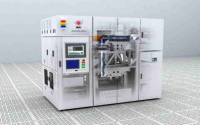Ye Tianchun: Globalization versus anti-globalization, China's integrated circuits need to shift from "catch-up" to "path innovation"
The current trend of "anti-globalization" is intensifying. The trend of localization of China's semiconductor industry has been making up for shortcomings and strengthening long-term chains. The re-evolution of globalization has made domestic and foreign manufacturers continue to think about new ways of cooperation. Ye Tianchun believes that to get out of the road of integrated circuit innovation with Chinese characteristics, it is necessary to establish internal circulation, guide double circulation, reshape the international integrated circuit circulation system, and shift from "catch-up strategy" to "path innovation strategy".
From April 17th to 19th, the 25th China Integrated Circuit Manufacturing Annual Conference and Supply Chain Innovation and Development Conference opened in Guangzhou, Chairman of IC Branch of China Semiconductor Industry Association, Vice Chairman and Secretary General of China Integrated Circuit Innovation Alliance, National Science and Technology Ye Tianchun, chief engineer of the major project 02 special technology, published a report on "Using Globalization to Reverse Globalization-Thoughts on the Road to Innovation of Integrated Circuits with Chinese Characteristics" at the meeting.
Current status of China's IC manufacturing, packaging and testing, equipment, and materials industries
In the past 15 years, policies such as major special projects, large funds, and the Science and Technology Innovation Board have led my country's integrated circuit industry to build a relatively complete system layout and comprehensive capabilities, and have established a solid foundation for a development path centered on China. More than 800 key backbone enterprises have been cultivated, and more than 150 listed companies have formed the "four beams and eight pillars" that support the development of the entire industry. There are more than 500,000 employees in the industry, including nearly 100,000 core innovation teams.
At present, the main challenge facing our country is that China's integrated circuit industry chain is bullish and highly dependent on the international cycle. In the past 20 years, China's integrated circuit industry has actively integrated into the international cycle. While developing rapidly, it has also formed path dependence.
The scale of China's electronic information manufacturing and chip imports continues to expand, and the manufacturing, packaging and testing, equipment, and materials industries are all growing. Among them, the design industry has grown by nearly 20% as of last year. Statistics from the implementation of major special projects in 2008 will increase by 13 times by 2022. After my country began to vigorously expand production in recent years, the growth rate of the manufacturing industry in 2022 will also reach 21.4%.
"At present, domestic capital still only accounts for 31.1% of China's integrated circuit manufacturing industry, which deserves our attention." Ye Tianchun said, "In the future, as the pace of production expansion in various places accelerates and production capacity begins to be put into use, this situation will be reversed. "
The packaging and testing industry has been showing steady growth. In the past two years, China has ranked first in the world in the traditional packaging market, and the proportion of advanced packaging is still not high, but it is also growing. In terms of growth rate, the growth rate of the packaging and testing industry has stabilized at around 10% in recent years, and the growth rate will remain at around 8.4% in 2022.
In the semiconductor supply chain, the growth rate of the equipment industry is very impressive, with a growth rate of 58% in 2021 and a growth rate of 36% in 2022. This is inseparable from the overall industry situation. On the one hand, China is actively expanding its production. On the other hand, due to the United States’ restrictions on China’s equipment imports in international trade, local equipment has gained more room for development and brought about faster growth. Statistics show that from 2008 to 2022, the sales of the domestic equipment industry increased by 30 times, and it is believed that this speed will continue for quite a long time.
The raw material industry (including pan-semiconductor materials) also remains stable, with a growth rate of 40% in 2021 and 25.4% in 2022. Due to the possible supply cut-off risk of imported products, driven by localized demands such as material supply chain security and industrial safety, the local raw material industry is expected to continue to maintain rapid growth.
In the market and manufacturing of end products, China has always had an advantage. More than 70% of electronic products are manufactured in mainland China, and it has the largest consumer market in the world.
From "catch-up strategy" to "path innovation strategy"
"To a certain extent, we have formed comprehensive capabilities in the field of 28 nanometers and above. This is not only technical capabilities, but also industrial supply capabilities have begun to form." Ye Tianchun said, so he believes that the next strategy should be to play the already formed The complete layout, coupled with China's super-large consumer and electronic product manufacturing market, forms a large internal cycle.
Reshaping the international integrated circuit circulation system, shifting from "catch-up strategy" to "path innovation strategy", "to give more play to the advantages of the rise of the Chinese market, to lead the global market with the Chinese market, to open up new tracks, to form internal circulation + double circulation, Reshape the global industrial chain." In the past, people paid more attention to making up for shortcomings and solving the bottleneck problem. Ye Tianchun believes that in order to really change the passive status quo, new strategies must be considered, centered on products, and driven by industry solutions.
Nowadays, the local integrated circuit industry is not only concerned by upstream manufacturers, but the downstream application manufacturers of integrated circuits in large industries such as new energy vehicles, consumer electronics, industrial electronics, power grids, and rail transit have also begun to pay attention to and consider chips. Their awakening will lead to system applications, and our integrated circuit design, manufacturing, and supply chain can be integrated and developed, and everyone can reach a consensus."
Outside of the market, Ye Tianchun believes that technological innovation
From following to leading, not just low-cost alternatives
China has encountered barriers on the existing technology path, which will force "path innovation" and bring opportunities to technologies such as FD-SOI and three-dimensional transistors.
In terms of design innovation, can higher performance be achieved with fewer transistors? This must be considered when reducing dependence on technology. The integration method from planar to three-dimensional will become a new way of technological evolution, and the trend of functional integration will expand a new space. Technological innovations such as design innovation, architecture innovation, electronic design tool (EDA) intelligence, and hardware open source have become new focuses.
In order to realize the transition from following to leading, China's integrated circuits should not only do low-cost substitutions, but introduce international resources through innovative application solutions, carry out global cooperation in the process of leading, and move from passive following to grasping the initiative and then cooperating. With the help of advantages in new energy vehicles, consumer electronics, network information equipment and other application fields, reconstruct the system, sort out the product system, and redefine chips based on China's existing integrated circuit capabilities, instead of blindly pursuing the latest technology. After the formation of this system, it is beneficial to use system innovation to alleviate the higher requirements for the chip itself.



